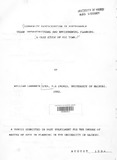| dc.description.abstract | Roads, water and sanitation are among the most important
infrastructural packages which form the environment.
Improved environment in urban areas depends among other
things on the provision, utilization and maintenance of
the above infrastructural :facilities. The study has
there:fore examined the in:infrastructure situation and how
it influences the current pattern of urban growth in Voi
town. The study has also examined the institutional set
up and its capacity :for planning and management o:f the
town. The study has shown that despite the importance of
roads and water supply on creation of employment
opportunities, improvement of incomes and smooth running
of urban affairs, the utilization and maintenance o:f
these two :facilities is inadequate. This is attributed
to lack of adequate resources by the Voi Municipal
Council, lack of adequate :financial resources by the
National Water Conservation and Pipe line Corporation,
due to the scattered pattern o:f development and :finally
due to the application of imported planning standards
which are not in accordance with the existing local
conditions.
It has been also established in this study that there
is no Municipal sewer. Most people use shallow not fully
serviced pit latrines. Household waste water is disposed
of by shallow trenches which are poorly maintained. The
poorly shallow maintained trenches are characterised by
stagnant water which form breeding grounds for mosquitoes
and also home for other disease causing vectors such as
worm infestations, diarrohea, skin and eye diseases. The
reasons as to why people use shallow not fully serviced
pit latrines and shallow trenches for disposal of
household waste water are the geological structure and
lack of financial resources. Topography was found to be
a factor affecting the general provision and utilization
of infrastructure in the town. To improve the current
infrastructure , the study examines the role of
the community in the planning and management of Voi town.
Furthermore, the study recommend ways of using the
community as o. means to achieving more sustainable
development and environmental quality in the town | en_US |

